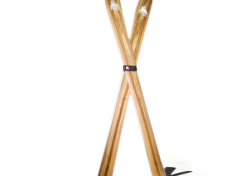There’s often a chasm between conceptual art and the rest of the world. But International Klein Blue (IKB), a colour devised in 1957 by French artist Yves Klein, is having a high-tide moment in couture and décor. IKB featured on Oprah, and since then fashion has pulsated with this fathomless indigo hue, with designers from Giorgio Armani and Jil Sander to Prada, Kenzo and Stella McCartney falling for it. You can even buy IKB sunglasses from Etnia Barcelona. Klein exhibited monochrome paintings, later patenting his formula and famously using it in his Anthropometries – filmed performances in which naked women rolled in IKB paint. Valeria McCulloch, also known as ValBlu, has worn IKB every day for the past 15 years and regards Klein as “a genius – the first artist to use a whole human being as a brush. Lots of designers have used IKB for inspiration: look at Yves St Laurent’s Jardin Majorelle in Morocco.” Part of IKB’s allure, she believes, is that deep blue has always been expensive. Ultramarine, made by grinding lapiz lazuli mined in Afghanistan, was prized in the Renaissance. And in the Christian tradition, dark blue has often denoted divinity.
Category Archive: 7 objects
There’s a reason why Jay Leno is crazy about pre-war motorbikes: so few survive from the period that those that do exist are highly prized and hugely collectable. In April 2014 the highest price ever achieved for a 1930s Brough Superior SS100 was reached at the Bonhams annual vintage motorcycle sale: £253,500, almost double its estimate. In April 2015, an even rarer machine will go under the hammer: the beautiful 1939 Vincent-HRD 998cc Series-A Rapide. This one, says Bonhams motorcycle expert Ben Walker, is “in concours condition, and one of those models that collectors and enthusiasts dream of: owned by one family since 1959, and the second-last ever to be produced”. Not all motorcycles are quite as good investments, according to Tennessee vintage bike broker Somer Hooker. “Buying a bike is like buying art,” he warns. “It’s worth buying something you like because you may have to live with it. People get tired of paper assets. It’s more fun to go out in the garage, see what you’ve got and take it for a ride.”
In 1846, just as the double wedding of Isabella II of Spain and her sister was inspiring the fashion for custom-made leather luggage and accessories, German-born Enrique Loewe Roessberg found himself in the right place at the right time. He established a reputation for supplying the country’s aristocracy with everything from vanity cases to gun holders in super-soft pigskin and nappa leather. From there the company name became fixed in the national consciousness – Loewe is to Spain what Hermès is to France. Like the newly resurgent Moynat, one of the original malletiers (trunk-makers), along with Louis Vuitton, Loewe’s forward-thinking creative director Stuart Vevers has cleverly repositioned the label to take advantage of a new golden age in luxury travel. A robust set of vintage-look travel trunks, such as this multi-purpose set by Loewe in beige and brown contrast trim, remains the ultimate in fashionable, functional travel. And while Loewe remains wedded in the popular imagination to the iconic Amazona bag, the luxury-lovers of today need something rather more capacious in which to store their many purchases made on global shopping trips by Learjet. loewe.com
Ask John Fry, president of the International Skiing History Association, why he believes there’s been an upsurge in wooden skis on slopes around the world, and he scratches his head. “To be honest, I have no idea. Wood was abandoned in the 1950s, when the metal ski was invented. By the 1972 Japan Olympics, everyone was using fiberglass. “Wood is a natural material, so it’s really hard to make two skis exactly the same,” he explains. “The torsing of the ski can’t be varied – whereas with modern composites, it can be. And then there’s the upkeep…” While Fry is right about the improved technical make-up of modern skis, he does recognize that “wooden skis do look nice”. So nice, in fact, that two enthusiasts have set up a website, vintagewinter.com, in order that enthusiasts can buy old pairs to adorn their chalets, homes and hotels. “Vintage winter sports items will always be in style,” says co-founder Jeff Hume. “There is something appealing about an old pair of solid-wood skis.” Which is why Pete Wagner in Colorado has cleverly come up with the perfect combination: hi-tech, ultra-strong skis that are custom-made using the most advanced engineering and materials, but finished with the sorts of beautiful wooden veneers shown here. “What people want is an old-fashioned aesthetic, but with 21st-century technology,” he says. Visitors to his website can fill out a form, and the company will design and ship skis anywhere in the world. Or simply, perhaps, to The St. Regis Aspen Resort, where they will be ready and waiting for guests on arrival. With or without wooden veneers. wagnerskis.com



